USDOT Thriving Communities Program: Billings, MT
25 minutes Date Launched/Enacted: May 30, 2025 Date Published: May 28, 2025
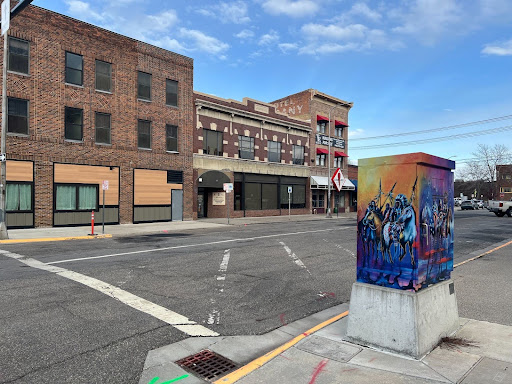
About the Thriving Communities Program (TCP)
The Thriving Communities Program (TCP) funds tailored technical assistance to under-resourced and disadvantaged communities, helping them better access historic infrastructure investments and deliver transformative projects. The USDOT FY 2022 Thriving Communities Program supports 64 communities across the country with access to a team of capacity builders to develop innovative community engagement methods, identify funding opportunities, and grow long-term capacity to develop and deliver transportation projects that strengthen communities.
TCP Complete Neighborhoods Community of Practice
TCP Communities are grouped into three Communities of Practice: Main Streets, Networked Communities, and Complete Neighborhoods. The 15 communities included under the Complete Neighborhoods Community of Practice are:
| Atlantic Beach, SC | Isabela, PR | Santa Cruz, CA |
| Billings, MT | Lansing, MI | St. Louis County, MO |
| Decatur, IL | Lima, OH | Suffolk, NY |
| East Orange, NJ | Providence, RI | Sumter, SC |
| Indianapolis, IN | Roanoke, VA | Waukegan, IL |
The US Department of Transportation (USDOT) selected a capacity building team led by RMI, including: the American Council for Energy-Efficient Economy (ACEEE), Equitable Cities, Nelson\Nygaard, and the Shared-Use Mobility Center (SUMC), to provide technical assistance to these 15 communities.

A Snapshot of Billings, MT
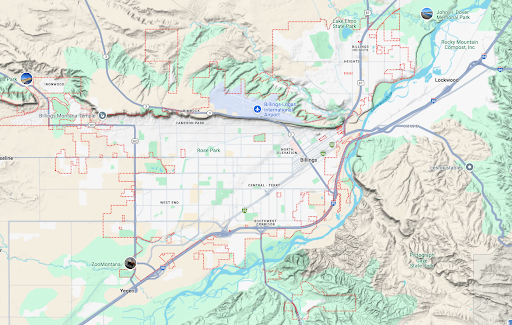
Satellite view of Billings, Montana. Credit: Google Maps
The city of Billings is the most populous in Montana, with a population of 117,116, and a median household income of $77,711 as of the 2020 Decennial Census. The city is located in the south-central part of the state, in Yellowstone County, with the Crow Indian Reservation located adjacent to the southeast of the County, and the Northern Cheyenne Reservation east of the Crow Reservation. The city was founded as a railroad town in the 1880s and continues to play a key role in trade in the area. The city and region have seen significant growth in the past decades, partly due to oil discovery and the more recent shale oil boom.
Within the City of Billings, there are five census tracts identified as disadvantaged. These census tracts are characterized as low-income, and several are at high flooding risk due to their proximity to the Yellowstone River.
Montana is home to approximately 78,000 people of American Indian heritage, or 6.5 percent of the state’s total population. The Crow tribe has a population of about 1,900 people and a median household income of $28,641, which is well below the state median household income of $60,560.
As of 2020, approximately 4.94% of the population in Billings identified as Native American, many of whom are members of the Crow, Northern Cheyenne, and other Native American tribes. It is believed that the actual number of Native American residents in Billings is higher. This discrepancy may be due to variations between federal and state self-reporting guidelines, and the final count does not include residents who identified as multiracial. A total of 6.1% of residents in Billings indicated two or more races, as part of the 2020 Decennial Census.
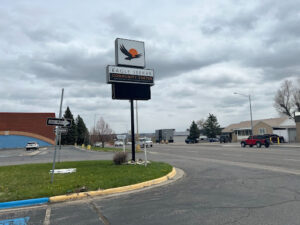
Eagle Seeker Community Center Sign facing Broadwater Ave, Billings, MT. Credit: SUMC
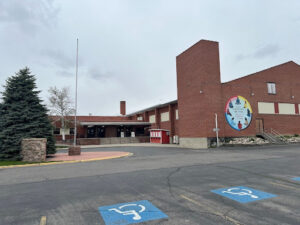
The Eagle Seeker Community Center. Credit: SUMC
Many tribal members from nearby reservations rely on the city for employment and essential services. A key resource for these communities is the Eagle Seeker Community Center, which was built in recent years to serve as a central gathering place for the local urban Native American community and surrounding tribes. It also serves as a space for community sporting leagues housed in their gym. The name “Eagle Seeker” symbolizes vision, leadership, and a commitment to the future, representing a pathway toward healing.
Another important resource located at the Eagle Seeker Community Center is the Billings Urban Indian Health and Wellness Clinic. This center provides a model of premier health and wellness services, offering accessible and culturally appropriate healthcare, and currently serves as the main provider of medical, dental and mental health services for Native Americans living in Billings. The center oversees shuttle transportation services to support those who need access to the clinic.
Key Initiatives for Transportation
The lack of active participation from urban Native Americans and other minority groups in planning and policy-making processes has posed a significant challenge for the city. This absence of involvement has influenced many decisions around city-wide funding and implementation efforts, resulting in inadequate transportation services, limited connectivity, and reduced access to mobility options for these communities.
Through TCP, the Native American Development Corporation (NADC), Big Sky Economic Development (BSED), and Seventh Generation InterTribal Center (SGEN) aimed to bridge the gap between the urban Native American community, city staff, and decision-makers. Their goals included gaining a deeper understanding of the local conditions and exploring opportunities to enhance Native American representation in the decision-making process for transportation improvements and policy-making. They sought to address barriers that hindered greater participation from tribal members living in Billings and to ensure that their interests and needs were taken into account in policy decisions.
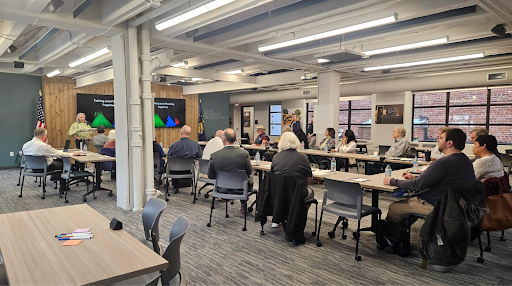
Let’s Talk Series, March 2025 Meeting at Big Sky Economic Development Offices. Credit: Dianne Lehm, Big Sky Economic Development
To facilitate this, the Let’s Talk Series was implemented as a strategy for fostering meaningful collaboration between Native American and non-Native American community members and organizations, as well as other minority community members, public officials, and agency staff. The series sought to develop a cohesive and widely accepted vision for the community through a number of meetings. Discussions during these meetings focused on various topics, including city-wide mobility, policy-making, economic development, civic engagement, youth involvement, education, safe streets, and healthy communities.
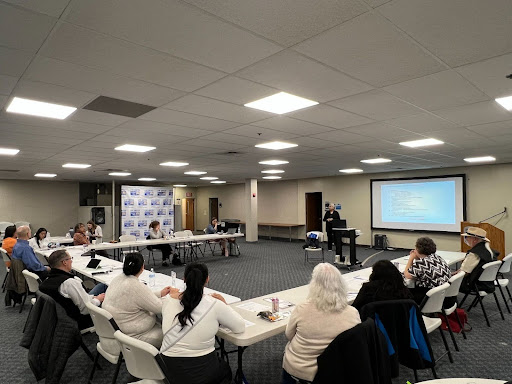
Let’s Talk Series Final Meeting, on April 24, 2025, at United Way Facilities. Credit: SUMC
Following the Let’s Talk Series, NADC, BSED, and SGEN are hoping to establish a Native American Advisory Committee to coordinate with local partners and advise city-wide projects and initiatives. Participants will include representatives from urban Native American communities and surrounding Tribes. The group will help identify important sensitivities to consider and pertinent information regarding the conditions and needs of tribal communities. It will help determine strategies for framing communication, and for engaging all population segments and maximizing participation at public events, as well as opportunities for coordination and synergy with other local and regional initiatives and planning activities impacting Billings.
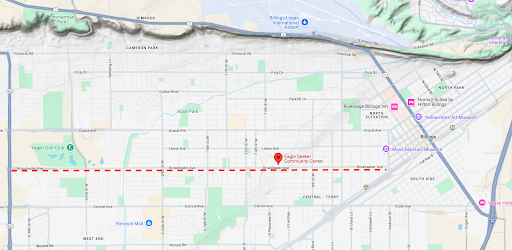
Broadwater Avenue, Billings, Montana. Credit: Google Maps
The Eagle Seeker Community Center was recently built to provide a space for local Native Americans to gather, collaborate, and grow. The center fosters a culturally rich and family-oriented environment, promoting learning, growth, and celebration of Native American heritage within the community. It is situated on Broadwater Avenue, a five-lane, high-speed corridor that lacks controlled intersections and high-visibility crossings. These factors create dangerous conditions for all road users, especially the more vulnerable users such as pedestrians, bicyclists, seniors, and people with disabilities, particularly at the intersection of 12th W Street, requiring pedestrians to cross at the peak of the hills. There’s also a bus stop without a shelter. The corridor stretches approximately five miles from east to west, linking the downtown district, NADC, and BSED headquarters on the west, and Shilo Road (MT-302) to the east.
The city of Billings received a Safe Streets for All grant in 2023 to fund construction projects that implement projects recommended in their Safe Routes to Schools Plan and Bicycle and Pedestrian Master Plan. In addition, the city is conducting a crossing study for the intersection of Broadwater Avenue and 12th Street, adjacent to the Eagle Seeker Community Center.
The Capacity Builder team reached out to the City of Billings-Yellowstone County MPO, Active Transportation Planner, currently managing the Safe Streets for All grant projects, and facilitated conversations with NADC and BSED to leverage this project as way for meaningful collaboration between urban Native American communities, and City staff, that help help inform prioritization of current planning and implementation projects. The City of Billings-Yellowstone County MPO is convening a steering committee and is in conversations with representatives of NADC to join the committee, support the educational campaign, and attend neighborhood meetings about the projects.
Key Partners
NADC, BSED, and SGEN are working with several key partners on these initiatives. Some of these partners include:
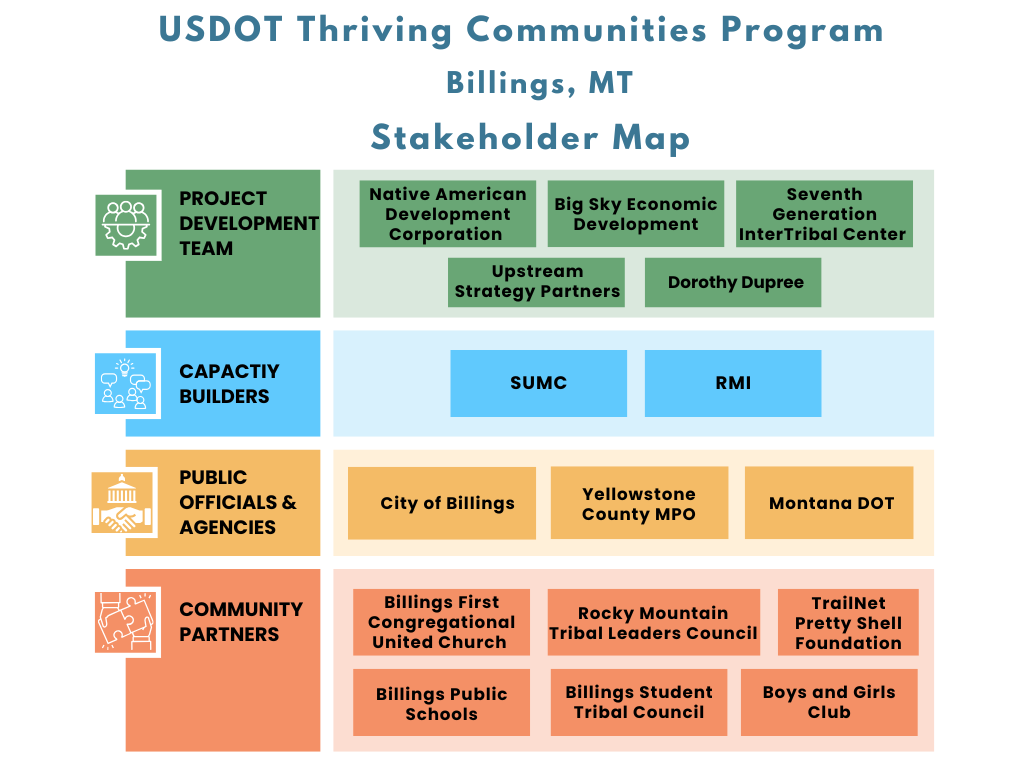
Stakeholder Map. Credit: SUMC
- Big Sky Economic Development (BSED) is a public-private partnership of The Big Sky Economic Development Authority (EDA), the public agency that evolved from the Montana TradePort Authority, launched in 1989 by the Yellowstone County Board of Commissioners. The organization’s mission is to sustain and grow Yellowstone County’s vibrant economy and outstanding quality of life by providing leadership and resources for business creation, expansion, retention, new business recruitment, and community development. They served as a key community partner in engaging stakeholders in the larger Billings area.
- The Native American Development Corporation (NADC) is a certified Native Community Development Financial Institution (CDFI) and acts as a hub for American Indian businesses. NADC provides technical assistance in the creation and operation of reservation-based Community Development Corporations, empowering communities toward economic and social stability. They possess a deep understanding of the strengths, weaknesses, threats, and opportunities that exist for Native American populations. Program areas and staff experience lend themselves to building solutions appropriate for the situation at a level appropriate to the people being served, resulting in good outcomes for individuals, Native entrepreneurs, families, and communities. They served as a key community partner with the engagement of tribal leaders and members in the Billings area.
- Shared-Use Mobility Center (SUMC) is a public interest non-profit organization dedicated to replacing car-centric transportation in favor of people-oriented shared mobility to fight climate change, promote equity, and strengthen the community. Throughout this project, SUMC provided education, outreach, and engagement support to the NADC and BSED, as well as provided tools, resources that support local capacity-building.
- RMI uses techno-economic expertise and whole-system thinking to provide technical assistance, original research, market-based analysis, and partnerships to transform energy systems. Utilizing their past experience with developing tools and resources to track and apply to federal funding opportunities, RMI supported the community with funding applications and provided project management expertise throughout the project period.
- Dorothy Dupree: provided technical assistance Native American Development Corporation and Big Sky Economic Development, supported the development of Let’s Talk Series program and facilitated the convenings.
- UpStream Strategy Partners: served as on-the-ground coordinator to support project implementation, Let’s Talk Series coordination, community event logistics, and promotion on the ground.
Activities through the Thriving Communities Program
Planning and Coordinating Activities
In February 2024, the Capacity Building team conducted a site visit during which TCP representatives met with local leads from NADC to tour the Eagle Seeker Community Center facilities to learn about the services they provide to tribal and community members. The group also walked around the Center to observe roadway and sidewalk conditions. During the site visit, the Capacity Building team and the Project Development team, formed by representatives of NADC, BSED, and SGEN, hosted three listening sessions:
- Listening Session with City and County Agencies: These sessions aimed to provide an overview of the Thriving Communities Program and the technical assistance available. Participants also had the opportunity to learn from local partners about current planning, infrastructure, and programmatic initiatives.
- Listening Session with Tribal Member Groups and Services: This session convened representatives of organizations that offer health, education, and cultural services to tribal members in Billings. The team presented an overview of the Thriving Communities Program and the technical assistance available. Participants discussed various efforts underway to support tribal members, shared their vision for the Eagle Seeker Community Center, and highlighted transportation and access issues faced by tribal members in reaching the Center and other destinations in Billings.
- Listening Session with Neighborhood Groups and Individuals: The session convened representatives of local organizations that advocate for and support development efforts and improvements in various neighborhoods and districts in Billings. The team provided an overview of the Thriving Communities Program and the technical assistance available. This session offered an opportunity to learn about ongoing projects and development efforts in Billings while hearing participants’ visions for the Eagle Seeker Community Center and their thoughts on transportation issues throughout the city.
During a second site visit in April 2025, the TCP Capacity Building team participated in the last two meetings of the Let’s Talk Series. Conversations centered around the cultural gaps that hinder mutual understanding and emphasized the value of multicultural collaboration, especially around civic engagement, policy, and planning processes.
The Capacity Building team helped lead a community-driven walk assessment training with representatives from NADC and BSED.
Community Engagement – Let’s Talk Series
Conversations between Native Americans and non-Native individuals in Billings are uncommon. This initiative was originally developed during Native American Heritage Month in November 2023 by SGEN. Its goal is to bring together leaders from the city of Billings and neighboring Tribal Nations, along with decision-makers from the community, urban Native Americans, non-Native residents, and various community organizations.
Native Americans in Yellowstone County have faced long-standing challenges, including limited transportation access in certain neighborhoods, public health and safety issues tied to the perception of the homeless population’s ethnicity, difficulties in finding safe and affordable rental housing, and a need for greater inclusion in policy-making and economic development decisions. NADC and BSED recognized this as an area of focus for the TCP project. Through conversations with SGEN, representatives from NADC and BSED decided to continue with the work started in 2023 as part of the Let’s Talk Series.
The Let Talk Series Part 2 strived to provide a friendly environment for meaningful conversations about the challenges faced by Native American communities, with conversations geared towards gaining a better understanding of the historical and current conditions that have contributed to these issues, exploring opportunities to overcome barriers that hinder Native Americans’ access to policy, planning, and decision-making processes throughout the city. The goals of the revamped initiative centered around fostering better Inter-Tribal communication and coordination, leveraging existing community, cultural, and city initiatives, and informing prioritization of planning and implementation projects in Billings (for example, Safe Streets for All grant projects, and Safe Routes to School Campaign).

Mayor Bill Cole addressing participants at the March 13, Let’s Talk Series meeting. Credit: Dianne Lehm
NADC and BSED contracted Dorothy Dupree, as she was part of the initial effort in 2023, to develop the program for the Part 2 Series and facilitate the meetings. Dorothy is a member of the Assiniboine and Sioux Tribes and was raised on the Fort Peck Reservation in northeastern Montana. She began her career working on Indian health issues in 1988 as Director of Finance for the Pascua Yaqui Tribe in Tucson, Arizona, and later served as the Executive Officer for the Indian Health Service within the Office of Tribal Activities in New Mexico.
To provide on-the-ground support, NADC and BSED selected UpStream Strategy Partners. Their team supported the planning and implementation of the Let’s Talk Series Part 2, community event logistics, and led promotion on the ground.
The first session was held on March 13, followed by additional events on April 3 and April 23 and 24.
During the first meeting, NADC provided an overview of the TCP project and discussed how this initiative aims to strengthen community infrastructure and create more inclusive and accessible transportation, particularly for urban Native Americans. Mayor, Bill Cole, highlighted the success of local efforts, such as the teepee lighting project, and emphasized the rapid changes occurring in the world. He stressed the importance of staying informed about both local and national initiatives, as well as the necessity of emotional intelligence in conversations around planning and policy-making. He noted that what we communicate is not always what is understood by others.
Participants recognized the need to create a space for these discussions and to develop strategies that facilitate collaboration between the public, non-profit, and private sectors. A key takeaway for participants was the importance of establishing a Native-focused community engagement and outreach process to improve communication and coordination between urban Native Americans and non-Native individuals regarding plans and projects in the city.
Some strategies identified during the discussions include:
- Using storytelling to connect across cultures.
- Learning and respecting Indigenous languages.
- Stepping outside of comfort zones to engage with unfamiliar groups.
- Improving access to public information through local TV and radio.
- Strengthening partnerships with businesses and community-based organizations.
- Supporting the involvement of Native youth in planning and policy-making processes by developing mentorship programs and introducing youth to role models in various sectors.
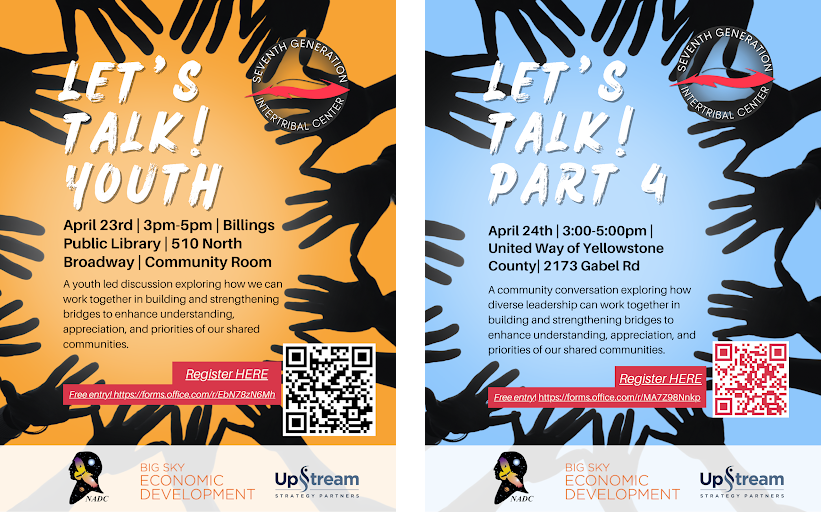
Let’s Talk Series Promotional Flyers for Youth and Closeout Events. Credit: UpStream Strategy Partners
Participants in the subsequent meetings discussed various topics, including performance, theatre, and the arts as strategies to foster a sense of belonging and revitalize public spaces. Many attendees noted the absence of visual and cultural representation that reflects the Native population within the community. They expressed the need for improvements to create a destination that celebrates Native American heritage while welcoming all community members.
Discussions also centered on several important topics, including economic development, the advantages of a vibrant and walkable and bike friendly streets for local businesses and tourism, the significance of healthy communities for sustainability and climate adaptation, the social determinants of health and suicide awareness. Additional topics included social justice, and civic engagement, all through the lenses of planning and policy processes. The key takeaways from each meeting were later organized into seven bundles or focus areas. In Native culture, bundles are considered sacred, and the number seven holds future-looking and sacred significance in Native traditions.
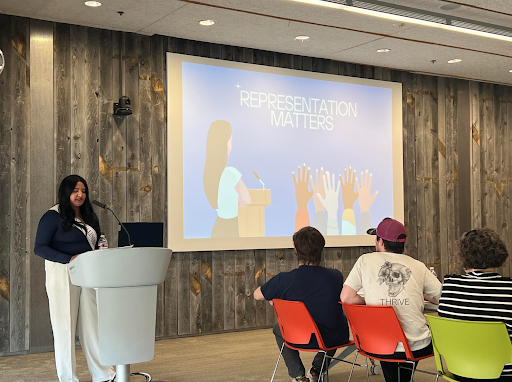
Whitney R, a local student, presenting during the Youth Event on April 23, 2025. Credit: SUMC
Participants in these meetings included various city staff, such as Mayor Bill Cole and representatives from the city council. They were joined by local organizations, including the Western Native Voice Community Organizer, Resilient Stories, Big Sky Economic Development, District 7 Human Resources Development Council and United Way. Representatives from the healthcare sector included Intermountain Health St. Vincent Healthcare, the Crow Nation Tribal Health and Indian Health Services (IHS). Among the educational institutions present were Rocky Mountain College, the Indigenous Education Department of Billings Public Schools, Billings School District, and MSUB. Additionally, youth organizations like the Billings Student Tribal Council and the Yellowstone Boys and Girls Club and Boys and Northern Cheyenne Girls Club participated, along with community members, native members, parents, and students, as well as Native organizations like the Rocky Mountain Tribal Leaders Council, the 7th Gen Intertribal Center Board and NADC.
The main message of Let’s Talk Part 2 was clear: ongoing conversations among urban Native Americans, the public, nonprofits, government, and businesses are essential. Honest and respectful discussions are crucial for bridging gaps, fostering understanding, and creating meaningful change in our communities. By listening, learning, and taking action, we can move forward together. To ensure the needs of the urban Native American community are met, we must prioritize listening. However, the City must be committed to facilitating change.
Capacity Building – Community Walk Audit

Walk Audit Route, Assessment of Broadwater Ave, Billings, MT. Credit: SUMC
In April 2025, the Capacity Building team returned to Billings to facilitate a community-driven walk assessment training with representatives from NADC and BSED. During this training, the Capacity Building team provides an overview of the benefits of walk audits, and walks the NADC and BSED through the process of planning and facilitating community-driven audits.

Representatives from NADC and BSED walking along the section of Broadwater Ave by Eagle Seeker Community Center. Credit: SUMC
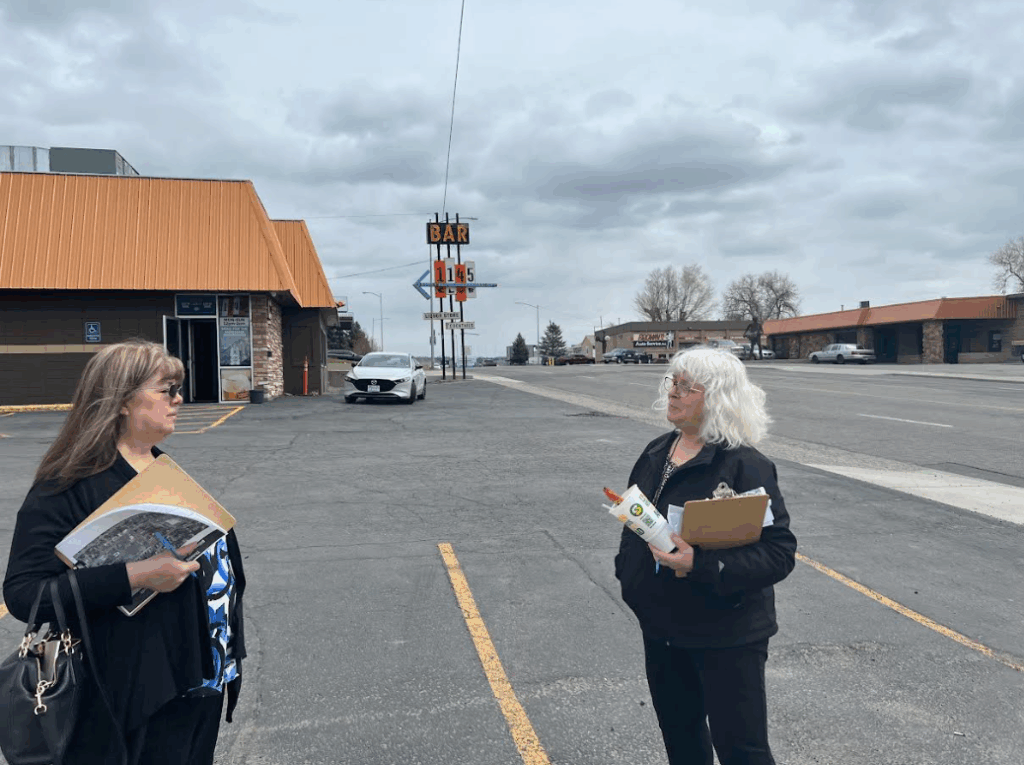
Representatives from NADC and BSED at the corner of Broadwater Ave and 12th Street. Credit: SUMC
The group walked along Broadwater Avenue, with special attention to the segment where the Eagle Seeker Community Center is located, and the intersection with 12th W Street. The group observed the existing conditions, available infrastructure, and built environment. During the walk, the group noticed a few individuals attempting to cross the busy corridor, by feet, car, and by bicycle. The pedestrians rushed to cross mid-section, given that the crossing on 12th W Street is currently located at the top of the hill, creating visibility issues and increasing the chances of vehicle-pedestrian collisions.
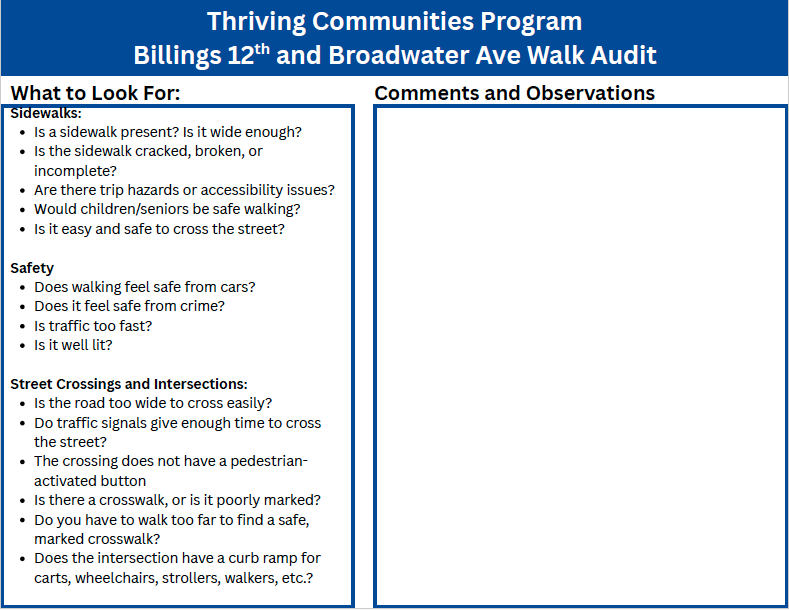
Walk Audit Assessment Sheet for Broadwater Ave, Billings, MT. Credit: SUMC
The group also highlighted that the current corridor design makes it very difficult for residents living in the surrounding neighbourhoods to safely access Eagle Seeker Community Center. The sidewalks are very narrow, offering barely enough room for 1 person to walk. At points, they are broken, missing, or uneven. There’s no buffer zone between sidewalks and the road. With heavy, fast traffic and large vehicles, this represents a significant concern for pedestrians and non-drivers, and the situation only worsens during the winter season.
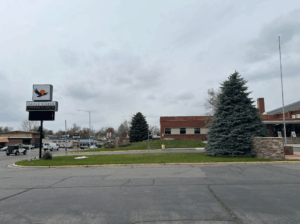
Eagle Seeker Community Center, Broadwater Ave entrance. Credit: SUMC
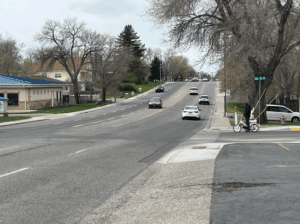
Cyclist at intersection of Broadwater Ave and 12 W St. Credit: SUMC

Pedestrian walking along Broadwater Ave. Credit: SUMC
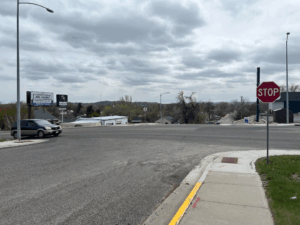
Four-way intersection at the corner of Broadwater and 11th W St. Credit: SUMC
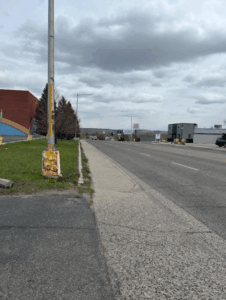
Narrow and uneven sidewalk, with a ramp section that favors cars over pedestrians at the entrance of Eagle Seeker Center and Broadwater Ave. Credit: SUMC
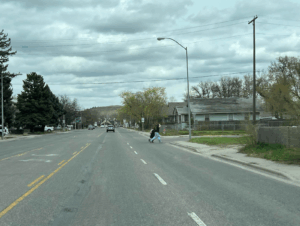
Local student and caretaker running across Broadwater Ave, after school dismissal. Credit: SUMC
After the walk, the group discussed potential traffic calming strategies to improve safety, and address mobility concerns of pedestrians and non-drivers along Broadwater, such as high visibility crossings, curb extensions (bulb-outs), lighting, wayfinding, and beautification efforts.
The goal is for NADC and BSED to host similar activities with users of the Center once the study on Broadwater Avenue and 12th W Street begins, to gather input from urban Native American communities, and help develop trust among the community and the City.
Next Steps for TCP Support
The Capacity Building team is developing a Walk Audit resource tool to enhance local capacity building. This resource will include information about the importance of safe, walkable streets and how planning for walkability can address pedestrian safety concerns. Additionally, it will feature a compilation of publicly available resources to help assess a community’s walkability, conduct walk audits, map routes, as well as training and funding opportunities.
Funding Opportunities
The Capacity Building team continues to work with NADC and BSED to identify suitable funding opportunities that allow outreach and engagement, capacity building and operations, and placemaking as eligible costs. NADC is currently exploring partnerships with foundations serving at the local, regional, and national level to further the work started through the TCP project.
Related Resources
Capacity building efforts through the Thriving Communities Program are continuing until May 2025. The Capacity Builder team will conduct more technical assistance activities and will update this case study as the program progresses.